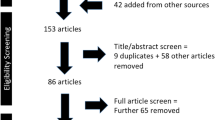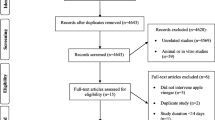Abstract
Background
Tea is an infusion of the leaves of the Camellia sinensis plant and is the most widely consumed beverage in the world after water. Green tea contains significant amounts of polyphenol catechins and represents a promising dietary component to maintain health and well-being. Epidemiological studies indicate that polyphenol intake may have potential health benefits, such as, reducing the incidence of coronary heart disease, diabetes and cancer. While bioavailability of green tea bioactives is fairly well understood, some gaps still remain to be filled, especially the identification and quantification of conjugated metabolites in plasma, such as, sulphated, glucuronidated or methylated compounds.
Aim of the study
In the present study, we aimed to quantify the appearance of green tea catechins in plasma with particular emphasis on their methylated forms.
Results
After feeding 400 mL of green tea, 1.25% infusion to 9 healthy subjects, we found significant amounts of EC, EGC and EGCg in plasma as expected. EGC was the most bioavailable catechin, and its methylated form (4′-O-Me-EGC) was also present in quantifiable amounts. Its kinetics followed that of its parent compound. However, the relative amount of the methylated form of EGC was lower than that of the parent compound, an important aspect which, in the literature, has been controversial so far. The quantitative results presented in our study were confirmed by co-chromatography and accurate mass analysis of the respective standards. We show that the relative abundance of 4′-O-Me-EGC is ~40% compared to the parent EGC.
Conclusion
4′-O-Me-EGC is an important metabolite derived from catechin metabolism. Its presence in significant amounts should not be overlooked when assessing human bioavailability of green tea.

Similar content being viewed by others
Notes
Bioavailability: in the present study, bioavailability is limited to plasma appearance of polyphenols over time.
Abbreviations
- AUC:
-
Area under the curve
- BMI:
-
Body mass index
- C:
-
Catechin
- C max :
-
Maximum plasma concentration
- T max :
-
Time needed to reach maximum plasma concentration
- EC:
-
(−)-Epicatechin
- ECg:
-
(−)-Epicatechin gallate
- EGC:
-
(−)-Epigallocatechin
- EGCg:
-
(−)-Epigallocatechin gallate
- MS:
-
Mass spectrometry
- SE:
-
standard error
- IS:
-
Internal standard
References
Graham HN (1992) Green tea composition, consumption and polyphenol chemistry. Prev Med 21:334–350
Crozier A, Jaganath IB, Clifford MN (2009) Dietary phenolics: chemistry, bioavailability and effects on health. Nat Prod Rep 26:1001–1043
Friedman M (2007) Overview of antibacterial, antitoxin, antiviral, and antifungal activities of tea flavonoids and teas. Mol Nutr Food Res 51:116–134
Miura Y, Chiba T, Miura S, Tomita I, Umegaki K, Ikeda M, Tomita T (2000) Green tea polyphenols (flavan 3-ols) prevent oxidative modification of low density lipoproteins: an ex vivo study in humans. J Nutr Biochem 11:216–222
Wolfram S (2007) Effects of green tea and EGCG on cardiovascular and metabolic health. J Am Coll Nutr 26:373S–388S
Thielecke F, Boschmann M (2009) The potential role of green tea catechins in the prevention of the metabolic syndrome—a review. Phytochemistry 70:11–24
Lee MJ, Wang ZY, Li H et al (1995) Analysis of plasma and urinary tea polyphenols in human subjects. Cancer Epidemiol Biomarkers Prev 4:393–399
Yang CS, Chen L, Lee MJ et al (1998) Blood and urine levels of tea catechins after ingestion of different amounts of green tea by human volunteers. Cancer Epidemiol Biomarkers Prev 7:351–354
Chow HHS, Cai Y, Alberts DS et al (2001) Phase I pharmacokinetic study of tea polyphenols following single-dose administration of epigallocatechin gallate and Polyphenon E1. Cancer Epidemiol Biomarkers Prev 10:53–58
Van Amelsvoort JMM, van Het Hof KH, Mathot JNJJ et al (2001) Plasma concentration of individual tea catechins after a single oral dose in humans. Xenobiotica 31:891–901
Lee MJ, Maliakal P, Chen L et al (2002) Pharmacokinetics of tea catechins after ingestion of green tea and (−)-Epigallocatechin-3-gallate by humans: formation of different metabolites and individual variability. Cancer Epidemiol Biomarkers Prev 11:1025–1032
Chow HHS, Cai Y, Hakim IA et al (2003) Pharmacokinetics and safety of green tea polyphenols after multiple-dose administration of epigallocatechin gallate and Polyphenon E in healthy individuals. Clin Cancer Res 9:3312–3319
Henning SM, Niu Y, Lee NH et al (2004) Bioavailability and antioxidant activity of tea flavanols after consumption of green tea, black tea, or a green tea extract supplement. Am J Clin Nutr 80:1558–1564
Chow HHS, Hakim IA, Vining DR et al (2005) Effects of dosing condition on the oral bioavailability of green tea catechins after single-dose administration of Polyphenon E in healthy individuals. Clin Cancer Res 11:4627–4633
Henning SM, Niu Y, Liu Y et al (2005) Bioavailability and antioxidant effect of epigallocatechin gallate administered in purified form versus as green tea extract in healthy individuals. J Nutr Biochem 16:610–616
Stalmach A, Troufflard S, Serafini M et al (2009) Absorption, metabolism and excretion of Choladi green tea flavan-3-ols by humans. Mol Nutr Food Res 53:S44–S53
Del Rio D, Calani L, Cordero C, Salvatore S, Pellegrini N, Brighenti F (2010) Bioavailability and catabolism of green tea flavan-3-ols in humans. Nutrition Article in press
Harada M, Kan Y, Naoki H, Fukui Y, Kageyama N, Nakai M, Miki W, Kiso Y (1999) Identification of the major antioxidative metabolites in biological fluids of the rat with ingested (+)-catechin and (−)-epicatechin. Biosci Biotechnol Biochem 63:973–977
Walle T (2007) Methylation of dietary flavones greatly improves their hepatic metabolic stability and intestinal absorption. Mol Pharm 4:826–832
Walle T (2009) Methylation of dietary flavones increases their metabolic stability and chemopreventive effects. Int J Mol Sci 10:5002–5019
Wen X, Walle T (2006) Methylation protects dietary flavonoids from rapid hepatic metabolism. Xenobiotica 36:387–397
Wen X, Walle T (2006) Methylated flavonoids have greatly improved intestinal absorption and metabolic stability. Drug Metab Dispos 34:1786–1792
Mada-Yamamoto M, Inagaki N, Kitaura J, Chikumoto T, Kawahara H, Kawakami Y, Sano M, Miyase T, Tachibana H, Nagai H, Kawakami T (2004) O-methylated catechins from tea leaves inhibit multiple protein kinases in mast cells. J Immunol 172:4486–4492
Mateos R, Goya L, Bravo L (2006) Uptake and metabolism of hydroxycinnamic acids (chlorogenic, caffeic, and ferulic acids) by HepG2 cells as a model of the human liver. J Agric Food Chem 54 (23) 8724–8732
Baba S, Osakabe N, Natsume M, Yasuda A, Takizawa T, Nakamura T, Terao J (2000) Cocoa powder enhances the level of antioxidative activity in rat plasma. Br J Nutr 84:673–680
Baba S, Osakabe N, Natsume M, Muto Y, Takizawa T, Terao J (2001) In vivo comparison of the bioavailability of (+)-catechin, (−)-epicatechin and their mixture in orally administered rats. J Nutr 131:2885–2891
Miketova P, Schram KH, Whitney J, Li M, Huang R, Kerns E, Valcic S, Timmermann BN, Rourick R, Klohr S (2000) Tandem mass spectrometry studies of green tea catechins. Identification of three minor components in the polyphenolic extract of green tea. J Mass Spectrom 35:860–869
Lee MJ, Maliakal P, Chen L, Meng X, Bondoc FY, Prabhu S, Lambert G, Mohr S, Yang CS (2002) Pharmacokinetics of tea catechins after ingestion of green tea and (−)-epigallocatechin-3-gallate by humans: formation of different metabolites and individual variability. Cancer Epidemiol Biomarkers Prev 11:1025–1032
Meng X, Lee MJ, Li C, Sheng S, Zhu N, Sang S, Ho CT, Yang CS (2001) Formation and identification of 4′-O-Methyl-(−)-epigallocatechin in humans. Drug Metab Disp 29:789–793
Meng X, Sang S, Zhu N, Lu H, Sheng S, Lee MJ, Ho CT, Yang CS (2002) Identification and characterization of methylated and ring-fission metabolites of tea catechins formed in humans, mice, and rats. Chem Res Toxicol 15(8):1042–1050
Renouf M, Guy P, Marmet C, Longet K, Fraering AL, Moulin J, Barron D, Dionisi F, Cavin C, Steiling H, Williamson G (2010) Plasma appearance and correlation between coffee and green tea metabolites in humans. Br J Nutr 9:1–6
Kotani A, Miyashita N, Kusu F (2003) Determination of catechins in human plasma after commercial canned green tea ingestion by high-performance liquid chromatography with electrochemical detection using a microbore column. J Chromato B 788:269–275
Acknowledgments
We would like to acknowledge for their help and support in this study Julie Moulin, Sylviane Oguey-Araymon, Anny Blondel-Lubrano, Maurice Beaumont, Mélissa Lepage, Bernard Decarli and William Sauret.
Conflict of interest
The study reported here was supported in full by Nestec SA. All authors are employees of Nestec SA.
Author information
Authors and Affiliations
Corresponding author
Rights and permissions
About this article
Cite this article
Renouf, M., Redeuil, K., Longet, K. et al. Plasma pharmacokinetics of catechin metabolite 4′-O-Me-EGC in healthy humans. Eur J Nutr 50, 575–580 (2011). https://doi.org/10.1007/s00394-010-0164-1
Received:
Accepted:
Published:
Issue Date:
DOI: https://doi.org/10.1007/s00394-010-0164-1




